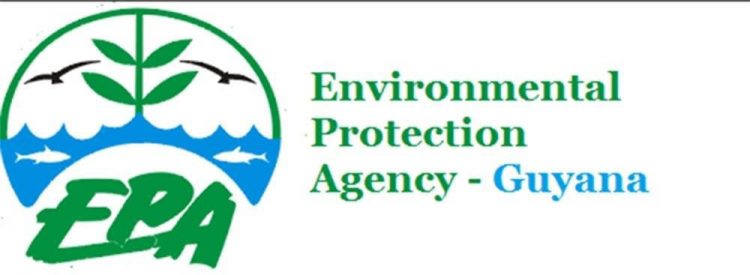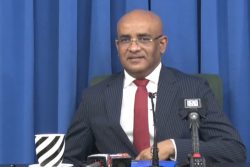Local affiliate of ExxonMobil—Esso Exploration and Production Guyana Limited (EEPGL)—is strongly contesting the High Court ruling, ordering the Environmental Protection Agency (EPA) to enforce the liability clause in permits for Exxon’s offshore oil operations here.
While Esso/EEPGL seeks to make a case for why it should not have to provide insurance and unlimited parent company indemnity to cover all environmental loss and damage that might result from a well blowout, oil spill or other failures in the Liza 1 Development Project in Guyana’s Stabroek Block; it was keen on guarding against its own losses which it pegged in the billions.
Esso strongly opposes the order directing it to provide unlimited liability to indemnify and keep the Guyana government and the EPA indemnified from any resulting environmental catastrophe.
 Earlier this month, High Court Judge Sandil Kissoon ruled that the EPA had breached the Environmental Protection Act by failing to enforce the liability clause in the permits issued to Exxon “…thereby putting this nation and its people in grave potential danger of calamitous disaster.”
Earlier this month, High Court Judge Sandil Kissoon ruled that the EPA had breached the Environmental Protection Act by failing to enforce the liability clause in the permits issued to Exxon “…thereby putting this nation and its people in grave potential danger of calamitous disaster.”
Advancing its case for why its permits should not be suspended, and in a bid to safeguard its own interest, however, Esso sought to explain how it would stand to lose financially.
It said that it has produced 151,000 barrels of crude petroleum per day for the year 2023 on average, through March 2023. “This is approximately 4.5Mn barrels per month,” it said; while going on to add that the most recent month’s average selling price for the Liza-1 petroleum was more than US$75 per barrel.
“This means the monthly revenue loss for the Appellant Esso the Co-ventures and the State is projected to be $US337.5Mn. This would amount to $US337.5Mn per month or $US4Bn per annum that would be forfeited each year while the appeal is pending,” Esso said.
Esso said that the Liza Petroleum Production License is for a limited term of time, while noting that it may be unable to recover lost production through the suspension of its permit.
Esso’s appeal comes on the heels of the EPA’s challenge to the court order directing it to enforce the liability clause in permits issued to Esso.
Esso had agreed in the permit to provide insurance and an unlimited parent company indemnity to cover all environmental loss and damage that might result from a well blowout, oil spill or other failures in the Liza 1 Development Project in Guyana’s Stabroek Block.
Earlier this month, Justice Kissoon ruled that the EPA had breached the Environmental Protection Act in failing to enforce the liability clause in the permits issued to ExxonMobil for Esso.
Among other things, the EPA contends in its appeal that the judge’s finding that the financial assurances set out in the permit were “unlimited;” was a flawed line of reasoning.
The EPA’s substantive appeal has not yet been heard, as the Court of Appeal is currently considering the preliminary issue of whether or not the challenge has any merit in the first place.
Hearing of this issue has been set for Monday May 29th before Justice of Appeal Rishi Persaud.
The EPA has asked for a stay, but the judge has since declined to grant any, stating that the stay will only be addressed if there is a need, since he intends to complete the matter before him, way in advance of the June 10th deadline set by the High Court for the EPA’s compliance.
In its appeal, Esso, too, is asking for a stay of the ruling of the High Court.
Esso’s appeal
Through their attorneys Edward Luckhoo SC and Andrew Pollard SC, Esso is asking the Guyana Court of Appeal to reverse and/or set aside the whole of Justice Kissoon’s decision and to dismiss the case brough by litigants Frederick Collins and Godfrey Whyte.
The oil extraction company argues among other things, that the order, which further states that failure to enforce would result in the permit being suspended, is “coercive.”
Describing its appeal as a “very arguable” one, Esso advances that Justice Kissoon erred in law when he determined that Esso was required by the permit to provide an unlimited parent company guarantee and indemnity agreement or affiliate company guarantee.
According to Esso the judge failed to consider that Condition 14:03 of the permit specifically stated that the forms of financial assurance were to be guided by an estimate of the sum of the reasonably credible costs, expenses and liabilities that may arise from any breaches of the permit.
The estimate Esso argues, “specifically excluded unidentifiable and inestimable costs associated with compensation for loss or ongoing damages to other parties and which are able to be pursued through civil action.”
Esso further goes on to argue among other things, that the trial judge failed to consider Section 31 of the Act which created a discretion on the part of the EPA to require financial assurance; and in particular subsection (2) which contemplates a specific amount of financial assurances which it argues reaffirms the policy that the assurances were never intended to be unlimited.
Among the numerous other errors which Esso argues the judge made, was when he “confused and conflated liability of the permit holder under the permit, with the requirements of the form of financial assurance.
It said that the judge also erred in his holding that the guarantees of US$2 billion was an unlawful attempt to dilute the conditions of the permit, and in particular Condition 14:01 which he ruled required unlimited guarantees.
According to Esso, the judge made findings not supported by the evidence when he concluded that Esso diluted its liabilities and was engaged in an attempt which was calculated to deceive; and further that it did not possess the financial strength, resources or capacity to cover its liabilities.
Esso said that although it has what it described as a “very arguable appeal with good prospects of success,” it stressed that if it is unable to comply, then its permit will be suspended.
On this point, Esso said that it stands to “suffer substantial loss and damage.”
Esso is hoping to be granted a stay of Justice Kissoon’s ruling while its appeal is being heard.
EPA’s appeal
In its appeal the EPA argues that the judge’s finding that the financial assurances set out in the permit were “unlimited; “was a flawed line of reasoning.
Describing the order made by the court that the permit stands suspended for breach of the Environmental Protection Act as “coercive”, the EPA contends that this will have severe consequences.
It argues also, that the directions given by the court have the effect of entirely removing its discretion, while adding that there would be “severe disruption to the national economy and financial well-being of the public and private sector.”
Describing Guyana as the “fastest growing economy in the world,” which it said was a “notorious public fact…due in large part to the exploitation” of its petroleum, the EPA says the order made by the court was critical to Guyana’s economic activity.
It says that Guyana now earns billions annually from its petroleum conducted on the Liza 1 and Liza 2 fields, both of which are subject to the permit. Against this background, the EPA advanced that suspension or cancellation would have a “catastrophic effect” on national funds for development and also the private sector which supports the activities on both Liza-1 and 2.
Advancing that its appeal has “a very good chance of success,” the EPA said, among other things, that the statutory underpinning for ‘financial assurance’ as it relates to its powers are set out in the Act.
The agency said Section 31(2) of the Act mandates that “the [financial assurance in any permit] shall specify the amount of financial assurance and may provide that the financial assurance may be provided, reduced or released in stages …”.
It stated that the Permit at Clause 14 provides for the financial assurance to be provided by Esso, and the consequences of any failure to so provide.
It argues that the provision of an unlimited guarantee was not contemplated by the Act.
Additionally, it says, the permit is a contract between the parties and “cannot be, in law, afforded an interpretation and application that would have the effect of overriding the clear provisions of the Act.
On the issue of its discretion, the EPA said the Act bestows this on the agency and it was therefore entitled to use it. “It is difficult for a court to direct and compel the exercise of the discretion of a public body when the choices available to the public body are equally meritorious,” the EPA said.
Background
In his ruling, Justice Kissoon said of the EPA, “It has abdicated the exclusive statutory responsibilities entrusted to it by Parliament under the Environmental Protection Act 1996 and the Environmental Protection Regulations 2000 to ensure due compliance by Esso Exploration and Production Guyana Limited.”
Collins and Whyte had argued through their attorneys that “…the agency, through its human minds, including its officers has failed or omitted to carry out or to show that it has carried out its legal duties and or obligations thereby amounting to misfeasance in public office by them and by failing or omitting to act, has acted unreasonably, irregularly or improperly and or has abused its power.”
Justice Kissoon had said that in the course of the proceedings, the court found on the evidence that EEPGL was engaged in a “disingenuous attempt which was calculated to deceive when it sought to dilute its liabilities and settled obligations stipulated and expressed in clear unambiguous terms at Condition 14 of the Environmental Permit (Renewed) while simultaneously optimising production at the Liza Phase 1 Petroleum Production Project in the Stabroek Block Offshore Guyana.”
Directly calling out the EPA, the judge said EEPGL “engaged in a course of action made permissible only by the omissions of a derelict, pliant and submissive Environmental Protection Agency.”
He said that the proceedings brought to the fore the adage, “but for the vigilance of citizens society shall perish.”
The court said it found that Esso was never in doubt as to what its liabilities were as captured under Condition 14 of the Permit, as the stipulations were neither unusual, unique or unauthorised.
Justice Kissoon went on to grant Collins and Whyte the orders they sought in the form of declarations. He also awarded them costs in the sum of $1,500,000.
The judge declared the EPA to be in breach of its statutory duty by its failure and/or omissions to enforce compliance by EEPGL of its financial assurance obligations, and keep indemnified the agency and the Government of Guyana against all environmental obligations of the permit holder and co-venturers within the Stabroek Block.
He also specifically declared that EEPGL had failed to comply with its financial assurance obligation; and further that Condition 14 imposes on EEPGL, “unlimited and uncapped liability for all costs associated with clean up, restoration and compensation for all damages caused by any discharge of any contaminant arising from its exploration, development and petroleum production activities within the Stabroek Block.”
The judge ordered the EPA to issue an Enforcement Notice pursuant to Section 26 (1) and (2) of the Environmental Protection Act, no later than May 9th, directing EEPGL to perform its obligations under the permit and to provide, within 30 days thereafter, the unlimited liability Parent Company Guarantee Agreement and/or unlimited liability Affiliate Company Guarantee to indemnify and keep indemnified the Government of Guyana and the agency against all such environmental obligations of Esso and its co-venturers within the Stabroek block, together with environmental liability insurance as is customary in the international petroleum industry in accordance with the Conditions 14 from an insurance company standing and repute that equates to Grade A Plus as envisaged by Condition 14.
Failure to comply with the order, the judge said, will result in the permit being suspended.
The orders made by Justice Kissoon are to be carried out no later than June 10th.










